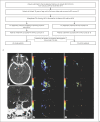Role of Favorable Perfusion Imaging in Predicting the Outcome of Patients with Acute Ischemic Stroke due to Large Vessel Occlusion Undergoing Effective Thrombectomy: A Single-Center Study
- PMID: 33454704
- PMCID: PMC7879261
- DOI: 10.1159/000513025
Role of Favorable Perfusion Imaging in Predicting the Outcome of Patients with Acute Ischemic Stroke due to Large Vessel Occlusion Undergoing Effective Thrombectomy: A Single-Center Study
Abstract
Introduction: We sought to verify the predicting role of a favorable profile on computed tomography perfusion (CTP) in the outcome of patients with acute ischemic stroke (AIS) due to large vessel occlusion (LVO) undergoing effective mechanical thrombectomy (MT).
Methods: We retrospectively enrolled 25 patients with AIS due to LVO and with a CTP study showing the presence of ischemic penumbra who underwent effective MT, regardless of the time of onset. The controls were 25 AIS patients with overlapping demographics and clinical and computed tomography angiography features at admission who had undergone successful MT within 6 h from onset and without a previous CTP study. The outcome measure was the modified Rankin Scale (mRS) score at 90 days.
Results: Sixty-four percent of the study patients had an mRS score of 0-1 at 90 days versus 12% of the control patients (p < 0.001). Patients of the study group had a more favorable distribution of disability scores (median mRS [IQR] score of 0 [0-2] vs. 2 [2-3]). Multivariate analysis showed that the selection of patients based on a favorable CTP study was strongly associated (p < 0.001) with a better neurological outcome.
Conclusions: In our small-sized and retrospective study, the presence of ischemic penumbra was associated with a better clinical outcome in patients with AIS due to LVO after MT. In the future, a larger and controlled study with similar criteria of enrollment is needed to further validate the role of CTP in patient selection for MT, regardless of the time from the onset of symptoms.
Keywords: Ischemic stroke; Modified Rankin Scale; Outcome; Perfusion CT; Thrombectomy.
© 2021 The Author(s) Published by S. Karger AG, Basel.
Conflict of interest statement
The authors have nothing to disclose.
Figures


References
-
- Berkhemer OA, Fransen PS, Beumer D, van den Berg LA, Lingsma HF, Yoo AJ, et al. MR CLEAN Investigators A randomized trial of intraarterial treatment for acute ischemic stroke. N Engl J Med. 2015 Jan;372((1)):11–20. - PubMed
-
- Saver JL, Goyal M, van der Lugt A, Menon BK, Majoie CB, Dippel DW, et al. HERMES Collaborators Time to Treatment With Endovascular Thrombectomy and Outcomes From Ischemic Stroke: A Meta-analysis. JAMA. 2016 Sep;316((12)):1279–88. - PubMed
-
- Goyal M, Menon BK, van Zwam WH, Dippel DW, Mitchell PJ, Demchuk AM, et al. HERMES collaborators Endovascular thrombectomy after large-vessel ischaemic stroke: a meta-analysis of individual patient data from five randomised trials. Lancet. 2016 Apr;387((10029)):1723–31. - PubMed
-
- Powers WJ, Rabinstein AA, Ackerson T, Adeoye OM, Bambakidis NC, Becker K, et al. American Heart Association Stroke Council 2018 Guidelines for the Early Management of Patients With Acute Ischemic Stroke: A Guideline for Healthcare Professionals From the American Heart Association/American Stroke Association. Stroke. 2018 Mar;49((3)):e46–110. - PubMed
-
- Astrup J, Siesjö BK, Symon L. Thresholds in cerebral ischemia - the ischemic penumbra. Stroke. 1981 Nov-Dec;12((6)):723–5. - PubMed
Publication types
MeSH terms
LinkOut - more resources
Full Text Sources
Other Literature Sources
Medical

